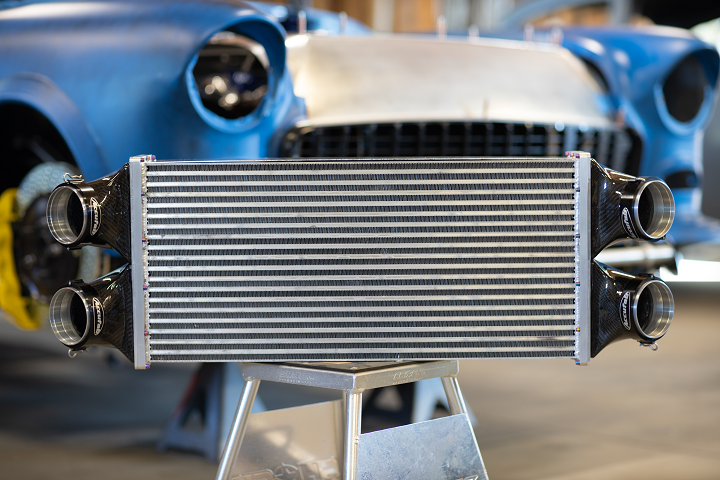You may recognize the name Brett Turnage from the amazingly detailed 3D printed RC cars and motorcycles he makes. But Turnage, founder of BTI LLC, has moved up and is now using 3D printing to improve upon life-sized cars. More specifically, BTI is 3D printing the molds used to fabricate its new Modular Heat Exchanger System, named the Manhattan.
According to BTI’s website, this patented system is “an innovative reimagining of how to construct intercoolers and radiators—changing them from fixed welded units to a system of multiple components.” While radiators are used to transfer thermal energy from one medium to another, an intercooler cools a gas after compression; the internal energy of a gas rises when it’s compressed, which lowers its density and increases its temperature.
Both intercoolers and radiators, often used in the aftermarket automotive market, are typically fixed units that have been welded together. But by using 3D printing to make molds for its intercooler and radiator end tanks, BTI can make a modular heat exchanger system that’s easy to take apart, fix, and redesign if needed.
“The original idea was to use 3D printing in plug making,” Turnage explained.
In this case, the plug would be the shape that would need to be molded later. But BTI took things to the next level.
“We’ve learned that we can completely skip that step and move straight to mold making once we have refined the shape in CAD,” he continued.
Using 3D printing to fabricate molds has many benefits, such as a shorter turnaround time, the ability to integrate conformal cooling channels, which conventional manufacturing technologies cannot do, and decreased costs, which leads to a competitive price.
“By skipping the typical mold making phase which required fiberglass, epoxy, gelcoat, and other consumables—we are able to save about $300-400 per heat exchanger, and we are also able to eliminate a week of build time,” Turnage explained.
“We can offer a better part, with better materials, all thanks to the savings that 3D printing is affording our manufacturing process.”
BTI’s patented Manhattan design replaces most of the welded joints that typically populate heat exchanger end tanks with a bracketed system, which, because it is not fixed, can be made with different materials, such as carbon fiber and other composites. With these types of new materials, the effectiveness, efficiency, and thermal quality of the whole unit increases.
“I built the Manhattan with the goal that it would be the best intercooler ever made,” Turnage writes on the BTI website. “It uses only the best heat exchanger cores, and it is designed inside CAD to ensure the highest airflow and efficiency.”
It takes about two days for BTI to 3D print the multiple sections that make up its molds, using several 3D printers. However, the molds don’t come off the print beds ready to go—a little refinishing work is required to ensure that the edges are all flush. Then, mold release is sprayed on and dry carbon is layered inside to make them strong enough to keep their shape under extreme pressure, as the company uses vacuum infusion to make its composite parts.
Turnage explained that “…the actual mold that can be vacuumed at 29 inHg (inches of Mercury) and then infused with resin is something that I did not plan on—I was amazed when I found out that we could do it and it has paid dividends in almost every area.”
He also went on to say that there are many benefits for the composites field by choosing to use 3D printed molds:
“If a company or a person wants to make a carbon part, they can decide whether a 3D printed mold will be the best solution…mainly the decision is based on how often the mold will be used. For a mold that is used frequently, I would still make a fiberglass mold, but for a mold that is only meant to make a few parts, then a 3D printed mold is more cost effective than a traditional mold.”
BTI’s Modular Heat Exchanger System, which will be available later this year, is currently a semifinalist in the Young Executives Network’s 2020 SEMA Launch Pad Competition, which offers a grand prize that’s valued at over $25,000. To help the Manhattan make it to the finals, you can vote for the system here. But you’d better hurry, as voting closes this Friday, September 11th. The finalists will be notified on September 18th, and the SEMA Launch Pad Live Event will take place on November 2nd, 2020.
(Images courtesy of BTI LLC)
Subscribe to Our Email Newsletter
Stay up-to-date on all the latest news from the 3D printing industry and receive information and offers from third party vendors.
You May Also Like
Profiling a Construction 3D Printing Pioneer: US Army Corps of Engineers’ Megan Kreiger
The world of construction 3D printing is still so new that the true experts can probably be counted on two hands. Among them is Megan Kreiger, Portfolio Manager of Additive...
US Army Corps of Engineers Taps Lincoln Electric & Eaton for Largest 3D Printed US Civil Works Part
The Soo Locks sit on the US-Canadian border, enabling maritime travel between Lake Superior and Lake Huron, from which ships can reach the rest of the Great Lakes. Crafts carrying...
Construction 3D Printing CEO Reflects on Being Female in Construction
Natalie Wadley, CEO of ChangeMaker3D, could hear the words of her daughter sitting next to her resounding in her head. “Mum, MUM, you’ve won!” Wadley had just won the prestigious...
1Print to Commercialize 3D Printed Coastal Resilience Solutions
1Print, a company that specializes in deploying additive construction (AC) for infrastructure projects, has entered an agreement with the University of Miami (UM) to accelerate commercialization of the SEAHIVE shoreline...



































